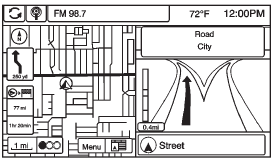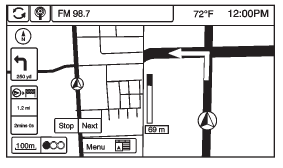Chevrolet Cruze Infotainment System: Navigation Symbols
Following are the most common symbols that appear on a map screen.

The vehicle symbol indicates the current position and heading direction of the vehicle on the map.

The destination symbol marks the final destination after a route has been planned.

The waypoint symbol marks one or more set waypoints.
A waypoint is a stopover destination point added to the planned route.
The estimated time and distance to the destination are displayed.

If waypoints have been added to the current route, each waypoint destination displays estimated time and distance.

This symbol indicates that the map view is North up: North up displays North at the top of the map screen regardless of the direction the vehicle is traveling.
Select this screen symbol to change the view to Heading up or 3D.

This symbol indicates that the map view is Heading up.
Heading up view displays the direction the vehicle is traveling at the top of the map screen. The shaded triangle indicates North.
Press this screen symbol to change to 3D mode.
The 3D symbol is the same as the Heading up symbol, but the map is in 3D.

The No GPS symbol appears when there is no Global Positioning System (GPS) satellite signal.

This symbol at the bottom of a map screen changes the current map mode screen.

This symbol on the right of the map screen displays the speed limit while on a route. The speed limit may not be accurate due to changes from the Department of Transportation, the local municipalities, or older map data.
Always follow the posted speed limit on the road.
Driving on a Route
Urgent Maneuver Alert
The system will give an indication that the next maneuver is close.

Driving on a Highway

Driving on a Residential Road
 Maps
Maps
This section includes basic information about the map database.
The data is stored in the internal flash memory that is used in the navigation
system.
Detailed Areas
Road network attributes are c ...
 Destination
Destination
If route guidance is not active, press the Destination Entry screen button on
the Home Page to access the Destination Entry screen. Several options can be selected
to plan a route by entering de ...
Other materials:
Installation Procedure
Create 6 x 20 mm (4/16 x 11/16 in) slots for MIG-brazing along the upper
edges of the service panel as noted from the original
panel.
Clean and prepare the attaching surfaces for brazing and spot welding.
Position the body lock pillar inner panel on the vehicle.
Verify the ...
Rear Spring Insulator Replacement
Removal Procedure
Raise and suitably support the vehicle. Refer to Lifting and Jacking the
Vehicle.
Support the rear axle with a tall jack stand near the shock absorber.
Remove the lower shock bolt. Refer to Shock Absorber Replacement.
Using the tall jack stands, slowly lower the rear a ...
Bluetooth (Voice Recognition)
Using Voice Recognition
To use voice recognition, press the
button located on the steering wheel.
Use the commands below for the various voice features. For additional information,
say “Help” while you are in a voice recognition menu.
Pairing
A Bluetooth-enabled cell phone must be paired to ...
